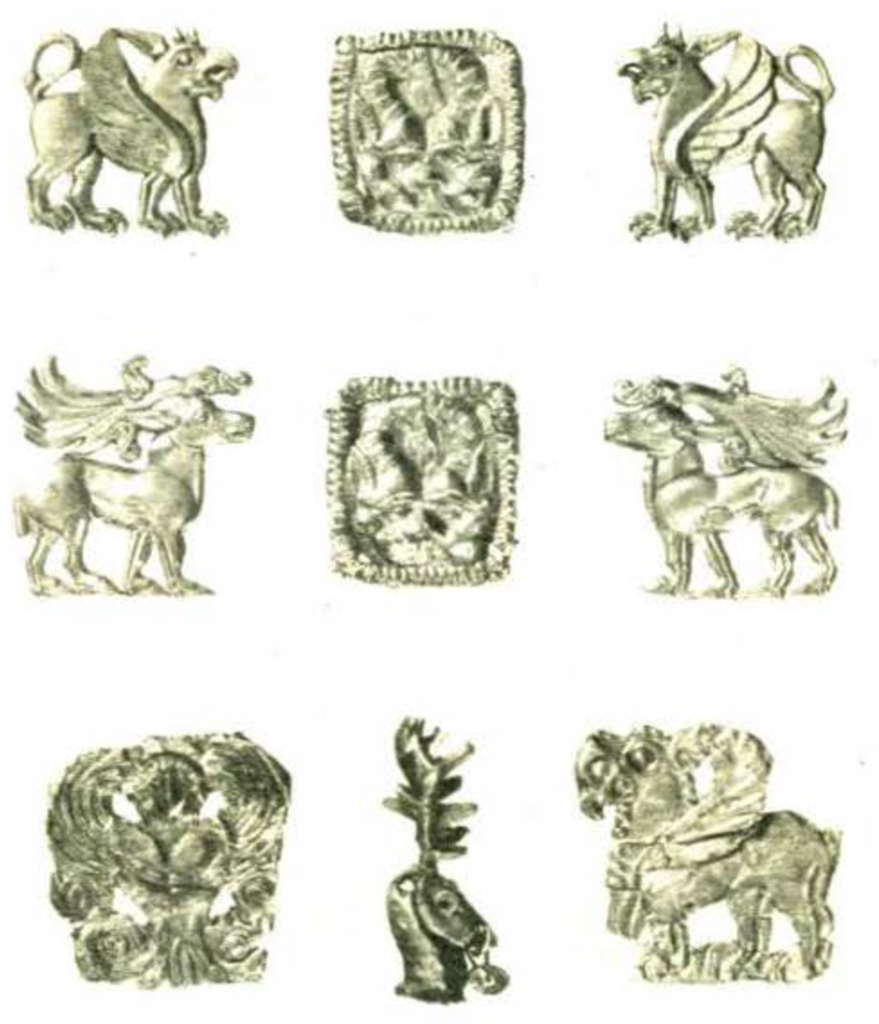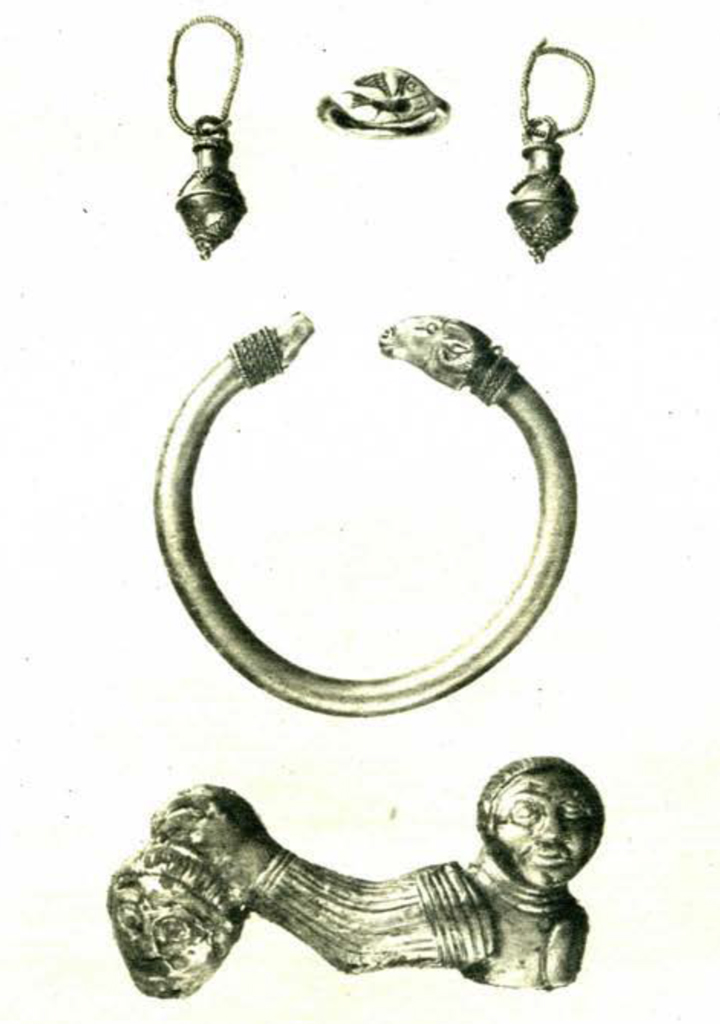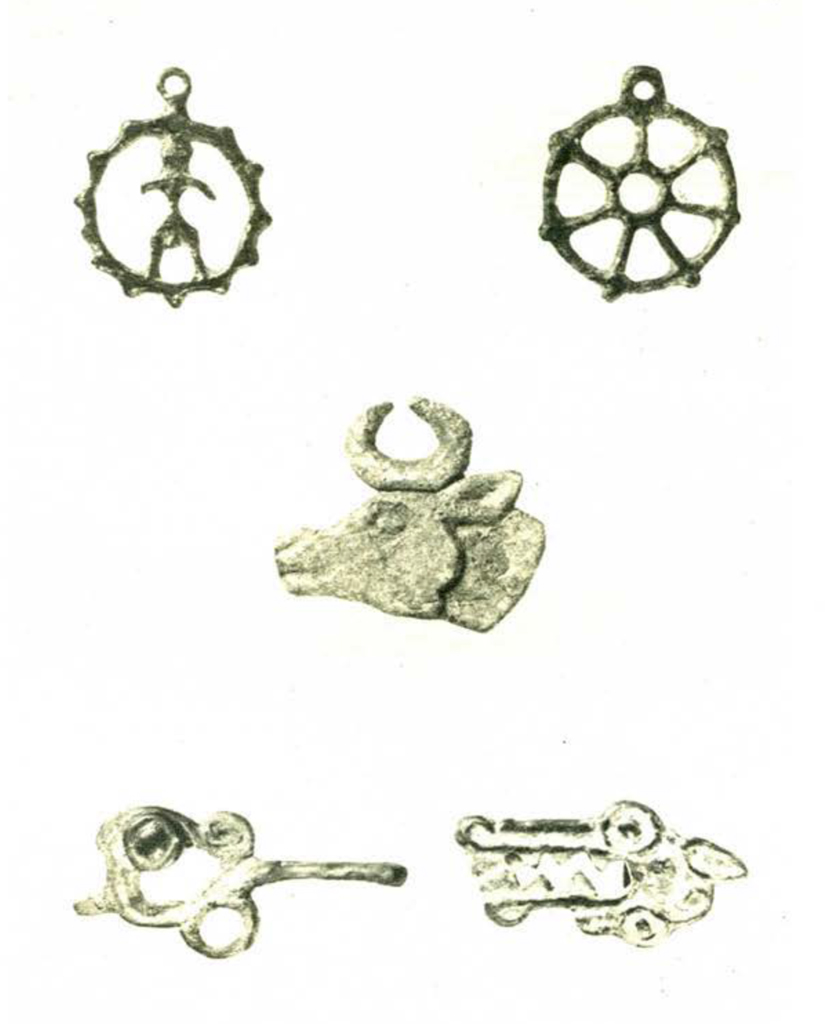
Museum Object Numbers: 30-33-13A / 30-33-13B / 30-33-14.1 / 30-33-14.14 / 30-33-14.4
ALTHOUGH the burial mounds or kurgans of South Russia have for many years been yielding interesting treasures in gold ornaments and bronze horse trappings, most of these have gone to the Hermitage Museum, Petrograd, and very little, until recently, has been seen outside of Russia. Thus, the acquisition of a group of antiquities of this sort from Maikop, in the Kuban region at the eastern end of the Black Sea, is outstanding among the recent accessions to the collections of the Museum.
The cream of the collection is the group of Scythian gold, of the fifth and fourth centuries B.C., and in this group the gold repousée ornaments from a tunic of cloth of silver are of the greatest interest and artistic value. Fragments of the original tunic were found with the ornaments, although they are now sewn on a similar garment of modern fabric. The ornaments consist of little plaques, beautifully fashioned, representing eagle-headed griffins, elaborately horned stags, palmettes, floral and geometric designs interspersed with small gold buttons. The tunic as a whole is among the most beautiful and interesting objects of Scythian workmanship yet discovered.

Museum Object Numbers: 30-33-7A / 30-33-10 / 30-33-7B / 30-33-9 / 30-33-31
In addition to this, there are many other personal ornaments-floral diadems, bracelets, anklets, finger rings and chains. The bracelet ending in a delicate ram’s head and the heavy chain of woven gold with three pendants of golden blossoms are of particular beauty. A large fibula of gold over bronze depicts a man holding at arm’s length the head of his enemy. In addition to the repousée work, there are pieces decorated in the granulated technique and others on which are cloisons containing fragments of coloured enamels.
Besides the gold there are various bronze weapons and harness ornaments, together with pins, bracelets, mirrors and objects of undetermined use, as well as Greek vase fragments, Sarmatian heads, and Egyptian scarabs which assist in dating various groups within the collection.

To the archaeologist the Scythian objects in the so-called “Animal Style” present the greatest interest. The animal style especially characteristic of Scythian art is being found to be more and more widely scattered all over the Asiatic continent in various modified forms. It is believed that the animal style had its beginnings before the third millennium. Whatever its original source, it had spread widely before historic times, and finds made on the Volga, in Southern Siberia and in North China show close relationship with these from South Russia. The famous Treasure of the Oxus now in the British Museum had no doubt a common origin. Even ancient Sumerian art seems in some way related, as well as small bronzes from the Caucasus, from Cappadocia, and recent finds from Persia. The style is known even as far west as Bulgaria and Hungary, and some claim its influence in Scandinavia. Thus the latest term applied to it is the “Urasian Animal Art.”
However, the region in which this art seems most at home and where it appears in its purest wild and untamed form is that of Siberia and South Russia, where in the Kuban district a flourishing Scythian kingdom existed from the sixth to the second century B.C., until it was conquered by the Sarmatians.
The Maikop treasure is said to have been found by a Russian farmer in 1912 working on his property near that place. It was taken to Paris in 1914 and there acquired by the late M. Ercole Canessa, from whose estate it was purchased by the Museum through the generosity of W. Hinckle Smith, Esq. It is probable that a collection of similar objects in the Berlin Museum and a smaller group in the Metropolitan Museum both belonged formerly to this same find.

